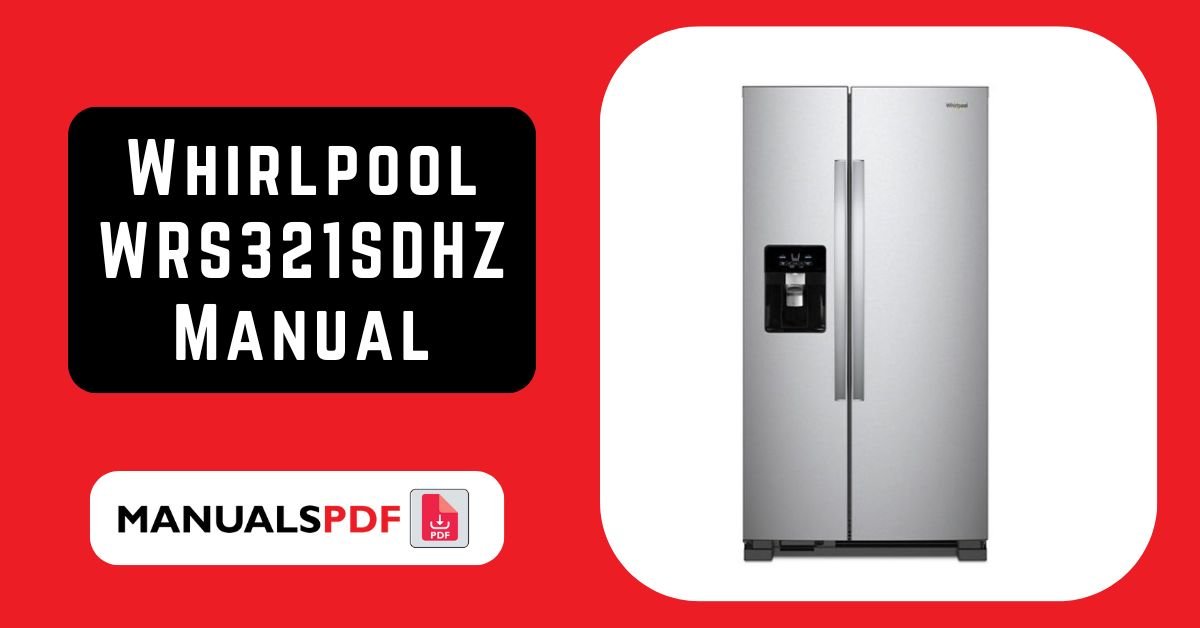The Whirlpool WRS321SDHZ is a 21.4 cubic feet side-by-side refrigerator with a sleek, modern design. It features a fingerprint-resistant stainless steel finish, which helps keep the appliance looking clean and new. This model offers convenient storage solutions, easy access to both fresh and frozen foods, and energy-efficient performance.
The complete manual for Whirlpool WRS321SDHZ is displayed below.
Table of Contents
Whirlpool WRS321SDHZ Manual PDF
Whirlpool WRS321SDHZ Specification
Model: Whirlpool WRS321SDHZ
Type: Side-by-Side Refrigerator
Dimensions:
- Width: 32.75 inches (83.2 cm)
- Depth: 34.75 inches (88.3 cm)
- Height: 65.88 inches (167.6 cm)
Weight: Approximately 235 lbs (106.6 kg)
Capacity: 21.4 cubic feet (606 liters)
Power Source: Electric
Energy Rating: ENERGY STAR® certified
Product Features
Fingerprint-Resistant Finish:
- Easy Maintenance: The stainless steel finish resists fingerprints and smudges, making it easier to clean.
Adjustable Storage:
- Adjustable Shelves: Customizable shelves in both the refrigerator and freezer sections allow for flexible storage options.
- Gallons-Size Door Bins: Spacious door bins can accommodate larger containers, freeing up shelf space.
Ice and Water Dispenser:
- External Dispenser: Provides easy access to ice and chilled water. The dispenser has a built-in water filter to reduce contaminants and improve taste.
Temperature Control:
- Electronic Controls: Allows precise temperature settings for both the refrigerator and freezer compartments, ensuring optimal food preservation.
LED Lighting:
- Bright Illumination: Energy-efficient LED lights illuminate the interior, making it easy to find items and see inside the refrigerator and freezer compartments.
Clear Crispers and Shelves:
- Visibility: Transparent drawers and shelves help you easily locate fruits, vegetables, and other items.
Frameless Glass Shelves:
- Spill-Proof Design: Glass shelves are designed to contain spills and prevent messes from spreading.
FreshFlow™ Air Filter:
- Odor Reduction: Helps to reduce odors and maintain a fresh environment inside the refrigerator.
Freezer Bins:
- Sliding Bins: Keep frozen items organized and accessible, reducing the need to dig through the freezer.
Dual Cooling System:
- Separate Cooling: Keeps the refrigerator and freezer compartments at the ideal temperatures by using separate cooling systems, reducing the transfer of odors between compartments.
Energy Efficient:
- ENERGY STAR® Certified: Meets stringent energy efficiency standards, helping to save on utility bills while being environmentally friendly.
Find the products here.
Also Read : Amana NTW4516FW Manual PDF
Frequently Asked Questions (FAQs)
What is the most common problem with Whirlpool refrigerator?
Not Cooling Properly: Check thermostat settings, clean condenser coils, and ensure the fan is working.
Ice Maker Issues: Clear blockages and inspect components.
Leaking Water: Clear defrost drain, check water supply line, and replace door seals.
Noisy Operation: Identify and replace faulty components.
Defrosting Problems: Replace defrost heater or thermostat if malfunctioning.
Door Seal Issues: Replace worn or damaged door seals.
Error Codes: Follow manual troubleshooting steps or consult a technician.
What is the average life of a Whirlpool side by side refrigerator?
The average lifespan of a Whirlpool side-by-side refrigerator is typically 12 to 15 years. This can vary based on factors like:
Usage Frequency: Regular use may lead to more wear and tear.
Maintenance: Proper maintenance and timely repairs can extend the lifespan.
Model and Build Quality: Higher-end models may last longer.
Installation Quality: Correct installation helps prevent premature issues.
What shortens the life of a refrigerator?
Factors that can shorten a refrigerator’s life include:
Lack of Maintenance: Not cleaning coils or ignoring repairs.
Overloading: Excessive weight or cramming too much food.
Inconsistent Temperature: Extreme settings causing strain.
Improper Installation: Poor ventilation or uneven placement.
Frequent Door Opening: Causes temperature fluctuations.
Power Surges: Can damage electrical components.
Clogged Vents: Restricts airflow and cooling efficiency.
High Ambient Temperature: Forces the fridge to work harder.

